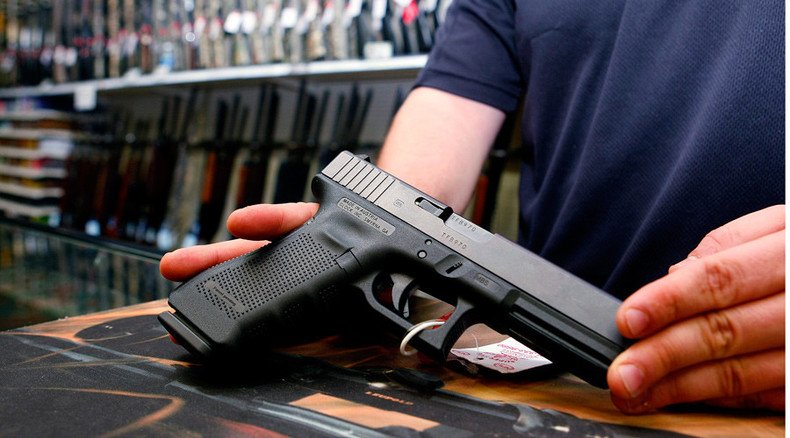'No coincidence’: US leads world in gun ownership & mass shootings, study says

Although the US accounts for just 5 percent of the world's population, it was home to almost one-third of the world's mass shootings between 1966 and 2012. A new study says the rate is due to shattered "American dreams" and the ease of gun ownership.
The research – titled 'Mass Shooters, Firearms, and Social Strains: A Global Analysis of an Exceptionally American Problem' – is the first quantitative analysis of all reported public mass shootings around the world. The study was presented at the American Sociological Association's annual meeting in Chicago on Sunday.
Analyzing data from 171 countries between 1966 and 2012, study author and University of Alabama Criminal Justice Professor Adam Lankford found that the US had by far the most public mass shooters, totaling 90 in the 46-year period – or 31 percent of the world's shootings.
Guns used for murder 32 times more than self-defense in US – Violence policy center http://t.co/iENcEYn1MPpic.twitter.com/NNyWiZPSS3
— RT (@RT_com) June 17, 2015That figure is five times more than the second-placed country, the Philippines, which had 18 mass shootings.
Those numbers are significant, considering around 300 million firearms are believed to be owned by US civilians. A 2011 Gallup survey found that 47 percent of all US adults reported keeping a gun in the home.
It's a link that cannot be ignored, according to Lankford.
“My study provides empirical evidence, based on my quantitative assessment of 171 countries, that a nation’s civilian firearm ownership rate is the strongest predictor of its number of public mass shooters,” Lankford said in a statement.
“Until now, everyone was simply speculating about the relationship between firearms and public mass shootings. My study provides empirical evidence of a positive association between the two.”
Lankford also pointed to another reason for the high rate of mass shootings in the US, suggesting that citizens are promised the “American dream,” but quite often fail to achieve the high levels of success they were guaranteed.
#VIRAL: Texas legalizes open carry of guns in public, on campus http://t.co/0y2WC7TRqFpic.twitter.com/hdBrt1oVLo
— RT (@RT_com) June 2, 2015"In the United States, where many individuals are socialized to assume that they will reach great levels of success and achieve the American Dream, there may be particularly high levels of strain among those who encounter blocked goals or have negative social interactions with their peers, co-workers, or bosses," Lankford said.
Those levels of strain are often combined with depression, schizophrenia, paranoia or narcissism, creating a lethal mix, the professor added.
“Unfortunately, due to some combination of strains, mental illness, and American idolization of fame, some mass shooters succumb to terrible delusions of grandeur, and seek fame and glory through killing,” Lankford writes in his paper. “They accurately recognize that the only way they can guarantee that their names and faces adorn magazines, newspapers, and television is by slaughtering unarmed men, women, or children.”
According to Lankford, those who conduct mass shootings in the US are also 3.6 times more likely to use multiple weapons than foreign shooters.
“Given the fact that the United States has over 200 million more firearms in circulation than any other country, it’s not surprising that our public mass shooters would be more likely to arm themselves with multiple weapons than foreign offenders,” Lankford said.
NRA-backed gun bill from GOP senator tackles mental health background checks http://t.co/xru8NQHy8jpic.twitter.com/A7lRvljJnW
— RT (@RT_com) August 6, 2015US shooters are also more likely to attack in schools, factories/warehouses and office buildings than offenders in other countries. Meanwhile, foreign attackers are “significantly more likely” to strike in military settings – including bases, barracks and checkpoints.
Lankford suggested the US could “likely reduce its number of school shootings, workplace shootings, and public mass shootings in other places if it reduced the number of guns in circulation.”
Through his analysis of 170 additional countries, Lankford found that the remaining top four nations for gun ownership – Yemen, Switzerland, Finland and Serbia – were within the top 15 countries in public mass shooters per capita.
"That is not a coincidence,” he said, stressing the link between the ease of firearm ownership and mass killings.
Lankford's study used the FBI's definition of mass murder, which indicates the killings of four or more people. The study excluded domestic incidents, as well as shootings that involved gangs, hostage-taking, or robberies.












